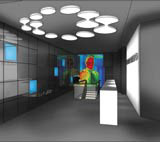A new dimension in branding
Nintendo is the latest household name to realise that a luxurious, hi-tech store is a foolproof way to lure in new customers, says Adam Woods

The problem with creating brands is that, however carefully you might construct them, however flawless and perfect they are in their conception, at some stage you have to let them out of the door to mix and mingle with all the other messages in the world.
That is undoubtedly why the leading brands are increasingly looking to branded retail to deliver the definitive embodiment of their message and values.
Nike and Levi’s are among those that have opted to breathe new life into their UK presence by moving into retail in recent years, and the appearance on London’s Regent Street of stores from electronics brands such as Apple Computer and Gizmondo further highlights the trend.
Two weeks ago it was Nintendo’s turn to strike out into the third dimension, with the grand opening of Nintendo World, the Japanese gaming giant’s first ever retail shrine dedicated entirely to itself, situated in New York’s Rockefeller Center.
‘I think most brands have taken a look at what Apple and Nike do and seen that they have done it very well,’ says a Nintendo spokesman. ‘It’s not all about the hard sell, it is about showcasing the brand.’
Like the Apple and Nike stores, Nintendo World is split into zones, themed according to Nintendo’s various consoles. The GameCube zone features ‘rumble seats’ that vibrate in time with the gameplay; the Nintendo DS space, focusing on the handheld console of the same name, has a sleek, minimal feel that owes something to the Apple stores; the Game Boy Advance SP area has its own bar.
‘It is about showing the brand off to customers in a place where they can mess about, play games and just enjoy themselves,’ says the spokesman.
A similar motivation drove Gizmondo to open up in London in April, though the new brand was also using retail as a statement of intent. As a result, its retail presence has been applauded by other Gizmondo stockists, who view the flagship store as a marketing support tool rather than as a retail rival.
According to Gizmondo global marketing director Peter Malmstrom, ‘Our retailers appreciate the fact that we are delivering a really quality experience [in the store], and that translates to the buyers they see in their own stores. Carphone Warehouse and John Lewis are pleased to see us on Regent Street, and they know that they will indirectly benefit.’
Dan Stubbs, business development manager at 2Heads, the multidisciplinary consultancy that created the store’s interior, says the need for the public to sample a complex product was the inspiration behind the experience.
‘Our approach was driven by the need to create a relaxed and informal, yet hi-tech environment which would enable the full functionality of the product to be demonstrated,’ he says.
‘The store is very strongly branded in Gizmondo’s corporate colours, so it gives the impression of walking around inside a giant Gizmondo device.’
The store takes a similarly revolutionary approach to technology. ‘We were the first people in the UK, if not Europe, to use 3D lenticular plasma screens,’ says Malmstrom. ‘We have used directional sound beams in there; we have got a holographic projector in the window.’
Malmstrom says Gizmondo is now considering a location in New York’s Times Square as a potential second store.
Of the branded retail store’s foremost exponents, Nike moved into retail far earlier than Apple; NikeTown arrived in London two years before the curtain opened on Apple’s first New York store. And while NikeTown has explored the idea of zoning to great effect, creating in-store ‘pavilions’, each focusing on a key sport, it is arguably Apple that has made the most striking aesthetic contribution to the branded store.
When it began rolling out its stores in the US in 2001, its explanatory statement was typically bald: ‘Apple currently has around 5 per cent market share in personal computers,’ it declared. ‘Out of one hundred computer users, five of them use Macs. We want to convince those other 95 people that Macintosh offers a much simpler, richer and more human-centric computing experience. ‘And we believe the best way to do this is to open Apple stores right in their neighbourhoods.’
Apple now has 104 stores worldwide, peddling its design aesthetic plus its technology platform. It recently held talks with British design groups about design-led installations in its London store.
Elements of Apple’s approach to retail – as a tool to crowbar open a market dominated by larger players – are evident in the approach of companies like Gizmondo. But the dual function of the dedicated retail store as an extravagant showcase for all things relating to a given brand is the one that truly offers designers the opportunity to display their own skills.
High street Brand-building
May 2005 – Nintendo World store launch in New York’s Rockefeller Plaza. Designed in-house at Nintendo, it marks the company’s first self-branded retail outlet in the world
March 2005 – Gizmondo opens flagship store on London’s Regent Street with interiors by 2Heads, featuring a holographic projector, directional sound and plasma versions of the 3D lenticular screen featured on the device itself
November 2004 – Apple Store launches in London, designed by Gensler and Eight Inc. The first 300 Apple fans through the door have the opportunity to buy a mystery goody bag for £249
July 1999 – NikeTown opens at London’s Oxford Circus, designed and built by Building Design Partnership
-
Post a comment




